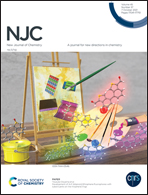Large-scale facile-synthesis and bistable emissions of one-dimensional organic–inorganic C4H14N2PbBr4 metal halide crystals with bipolaronic states†
Abstract
Low-dimensional metal halides have attracted much attention because of their excellent physical properties and potential application in optoelectronic field. Herein, we developed a novel facile method based on mechanochemical synthesis to prepare one-dimensional (1D) C4H14N2PbBr4 (C4H14N22+: N,N′-dimethylethylenediamine cation) micro-crystals on a large scale. This 1D structure enables the formation of self-trapped excited states that exhibit bluish white-light emission, and the photoluminescence quantum yield (PLQY) is about 18.4% under excitation of a 365 nm ultraviolet (UV) lamp. Interestingly, C4H14N2PbBr4 exhibits an unusual bistable emission, i.e., when excited by a 365 nm beam from a UV lamp, its emission occurs at about 461 nm, while excited by a 365 nm laser pulse, its emission maximum is located at 546 nm. The formation of self-trapped exciton (STE) pairs (bipolaron) via coupling of two adjacent PbBr42− clusters by di-amine groups results in the bistable emission in the 1D chain. It is worth mentioning that the as-synthesized C4H14N2PbBr4 has the advantages of high chemical, thermal and photostability, and large-scale manufacture along with remarkable photophysical properties, which provide a broad prospect for optoelectronic applications.



 Please wait while we load your content...
Please wait while we load your content...